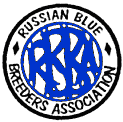| Home>The Breed |
An Introduction to the Russian Blue
<WHAT IS A RUSSIAN BLUE? The Russian Blue is a short haired cat of foreign type, but it is not as extreme in "type" as the Siamese and other orientals. The body is long and graceful with medium strong bone. Legs are long with small oval paws and the tail is fairly long and tapering. The short, wedge-shaped head is topped by large pointed ears, set vertically to the head. The Russian Blue has prominent whisker pads and vivid green almond shaped eyes. The coat of the Russian Blue is quite different from that of any other breed, being short, thick but fine and standing up soft and silky with a silvery sheen. A good Russian Blue should have an elegant appearance with an aristocratic expression.
WHAT IS ITS HISTORY? The Russian Blue Breeders Association has published an informative and interesting handbook which includes a detailed history of the Russian Blue. It is thought that the cats were first brought to this country by sailors in 1860 from the port of Archangel. They were then known as Archangel cats.
WHAT KIND OF PERSONALITY DOES IT HAVE? Naturally, this will vary from cat to cat, but the Russian Blue is an intelligent cat which is renowned for its gentleness. It will often talk to its owner in a quiet voice, although a queen in season can make as much noise as any other cat. The Russian Blue is affectionate but not demanding. Many love to be picked up and cuddled but some are not so keen. Nevertheless, they are still likely to be loving and devoted companions to their owners. This has made the breed particularly popular with elderly people. However, it is also very good with children and as a general rule will tolerate the clumsy handling of a child. The cat will wriggle, rather than claw, its way out of a tight grip. It is rare for a Russian Blue to bite or scratch.
CAN A RUSSIAN BLUE BE KEPT INDOORS? Although the coat is ideally suited to cold weather, the Russian Blue tends to be a home loving cat and should not suffer from being confined to the house, provided there is ample opportunity for adventure and play with its owner. If the cat would be left alone for much of the day, it would be kinder to get two. If you need to keep your cat indoors do bear in mind that you will need to keep windows screened and that it is difficult to keep a cat in if you have young children or frequent visitors at your door.
(Note that the GCCF, CFA and TICA standards are slightly different! This refers to the GCCF standard.
The CFA standard can be found at http://www.cfainc.org/breeds/standards/russian.html
while the TICA page is http://tica.org/public/breeds/rb/rb.pdfhttp://tica.org/public/breeds/rb/rb.pdf).
You can email a member of the committee of the Association, to get a more direct answer. (I forward most queries to her anyway!)
Email addresses protected by JavaScript.. Pleass enable javascript.
